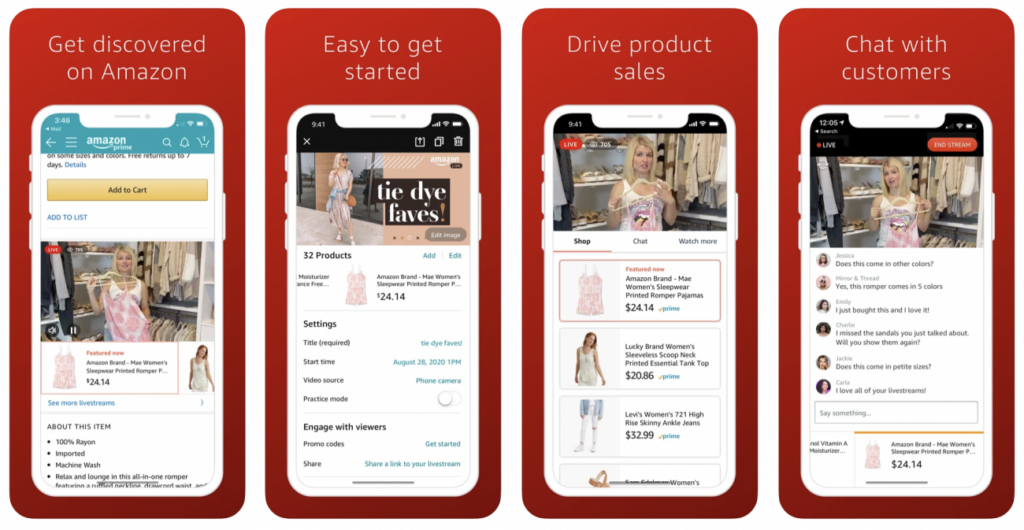Amazon Sellers Are Excited About Livestream Selling – Here’s Why!

Like the idea of bringing more traffic to your Amazon listing? There’s a new influencer in the Amazon marketplace you need to be aware of, and it isn’t a Kardashian.
Over the last 24 months, the viral profit-margin strategy has made its way across the ocean. Now, it’s fueling online sales, and in the process, it’s become one of the biggest success stories of the past year.
Live stream shopping originated in China as a revolutionary e-commerce trend, combining real-time video streaming with interactive shopping to captivate consumers and drive sales.
This post takes a close look at what a lot of very successful ecommerce sellers are so excited about.
What is Livestream Shopping?
Livestream shopping is part of a larger trend referred to as social commerce. Also known as live shopping or live commerce, livestream shopping combines real-time video streaming with ecommerce functionality.
With livestream shopping, a host—often an influencer or brand representative—showcases products in a live broadcast, allowing viewers to watch demonstrations, ask questions, and make purchases directly within the stream.
A live shopping platform enables viewers to click product links, add items to their cart, and complete transactions without leaving the stream. Hosts often use tactics like limited-time offers, exclusive deals, and interactive elements to drive engagement and create urgency.
This format bridges the gap between traditional retail and online shopping, offering a more personal, interactive, and engaging way for consumers to discover and buy products.
Ready to Start Growing Your Amazon Brand?
Canopy’s Partners Achieve an Average 84% Profit Increase!
Find out moreWhat is Social Commerce?
Social commerce blends social media and ecommerce, allowing the entire purchasing journey—product discovery, research, and checkout—to occur directly within social media platforms.
This approach leverages the large user bases and high engagement of social networks to connect businesses with consumers seamlessly.
Key Features of Social Commerce:
- Seamless Integration: Users can browse, shop, and make purchases without leaving their favorite social media apps.
- Interactive Shopping: Features like shoppable posts, live shopping events, and user-generated content create engaging, real-time shopping experiences.
- Social Proof: Reviews, ratings, and recommendations from peers and influencers build trust and credibility.
- Personalized Recommendations: Data-driven algorithms suggest products tailored to users’ interests and behaviors.
- Direct Communication: Brands can interact with customers through comments, messages, and live chats.
But first . . .
A Very Short History Lesson
China has a history of technological innovation. The country is responsible for a number of world-changing inventions including, paper making, movable type printing, gunpowder, the compass, and alcohol.
However, in the last several decades, China had reached the point where as recently as 2014, the Harvard Business review had written an article titled, Why China Can’t Innovate. The article hinted at problems with the Chinese educational system, as well as the government’s inability to protect intellectual rights, and the fact that Chinese startups were being founded by engineers, not designers or artists.
A lot has certainly changed since 2014.
Now, China Has Flipped the Script
Chinese technology had become known for copying Western merchandise then turning around and producing it at incredible scale, and at a price that made it hard for the world to compete with.
However, in very short order, China pivoted and has now transitioned into a tech super power. One surprising reason that this happened had nothing to do with market changes or economic theory. The Chinese government itself was determined to change the way that the world viewed their technological capabilities. They wanted to be known as more than clever, cost-conscious duplicators.
Because of that, over time, China’s government reportedly “encouraged” landlords and developers to terminate the leases of businesses that produced predictable merchandise, and to welcome companies that promised to innovate.
One of the best examples of a forward-thinking Chinese business is DJI, a Shenzhen-based startup that dominates the private drone industry. DJI controls nearly three-quarters of the consumer drone market, with approximately 80% of its sales coming from outside China.
Recently, China has taken their innovation in a completely different direction, and has given us a glimpse of what the future of world-wide shopping might look like.

Increasingly, Online Shopping is Going Live
Since Alibaba’s launch of Taobao Live in 2016, live selling has steadily expanded worldwide. While adoption in the U.S. lagged behind China initially, the U.S. live commerce market has seen substantial growth in recent years.
By 2026, the market is projected to reach $68 billion, accounting for over 5% of total ecommerce sales—an impressive leap reflecting its rapid adoption.
Major players are driving this growth with significant investments in livestream commerce:
- Amazon launched its Amazon Live FAST Channel on Prime Video and Freevee, enhancing accessibility to shoppable entertainment.
- Poshmark, now owned by Naver, expanded its Posh Shows platform, hosting themed live shopping events like Earth Month celebrations in 2024.
- TikTok Shop introduced in-app purchasing and payment features, revolutionizing the U.S. live shopping experience.
- YouTube partnered with Shopify to enable direct purchases from its platform, while Walmart and eBay continued enhancing their live shopping features.
- Qurate (QVC’s parent company) developed Sune to cater to younger audiences with seamless, on-demand live shopping.
Livestream Shopping is Rapidly Gaining Traction on Amazon
In 2024, Amazon partnered with TalkShopLive to elevate its live shopping experience, debuting exclusive shows and curated deals for Black Friday.
This collaboration featured well-known personalities like Martha Stewart and Eva Mendes, showcasing curated products across diverse categories. In 2025, Amazon is expected to make live shopping events even more engaging by integrating AR/VR technologies, enabling virtual try-ons and 3D product interactions.
The evolution of Amazon social selling reflects the rising demand for personalized, interactive shopping experiences that seamlessly combine entertainment and convenience.
Virtual Reality is Making Inroads with Ecommerce
Don’t like the idea of balancing awkwardly on one leg in a tiny changing room? Snapchat users can now try on clothing and accessories virtually with technology that responds to your own specific physical dimensions.
For the last several years, China has also been behind the surge of live streaming events. It’s like the Home Shopping Network on steroids, but with hip, media-savvy (usually younger) influencers.
Virtual reality (VR) is a simulated experience that can either mirror real life, or take the user on a mind-bending alternative journey. Traditionally popular with gamers, what VR attempts to do is create a sensory experience for the user. This experience can include sight, touch, hearing, smell, and even taste.
The consumer virtual reality (VR) market is anticipated to grow from under $16 billion in 2024 to over $18 billion by the end of 2025. This notable increase highlights sustained interest and investment in VR technologies, underscoring the industry’s rapid growth and potential.

TikTok Has an Outsized Role in Social Commerce
We’re all holding our breath waiting to hear the upcoming US Supreme Court’s ruling on TikTok.
In the meantime, TikTok has revolutionized social commerce by blending entertainment with shopping, creating a powerful platform for brands to connect with their target audience and boost sales.
TikTok Shop has streamlined the purchasing process, allowing users to buy products directly within the mobile app, capitalizing on impulse buying behavior and reducing cart abandonment.
The platform’s unique algorithm and content format give it a competitive edge over other social media channels like Facebook and Instagram, offering higher organic reach and more engaging short-form video content.
TikTok’s emphasis on user-generated content and interactive features such as challenges, duets, and live chats fuels high levels of customer engagement.

Amazon’s Own “Live” Feature is Catching Fire
Amazon’s Live feature allows sellers to engage with shoppers in real time.
Using Amazon Live, sellers can bring products to life by featuring them in their product carousel. To engage with their audience during the streams, sellers can take advantage of features such as:
- Product highlighting,
- Live promotions
- Interactive chat
To help brands and influencers create, capture and manage livestreams, Amazon has also launched the Amazon Live Creator app.
Broadcasting Your First Livestream
Live video gives you a way to bring your product to life and engage with shoppers. When you go live, your stream will appear automatically on your influencer storefront and on the Amazon Live home page.
With the Amazon Influencer Program, you can earn commissions on qualifying purchases. This includes products you show during your livestream event.
There are many different broadcast software options available for livestreaming ecommerce video. Amazon recommends the following settings when setting-up a livestream.
If you’d like assistance leveling up your own brand’s social commerce, the omni-channel experts at Canopy Management are here to help.
Canopy Management is a full-service marketing agency for Amazon, Walmart, and TikTok sellers. Our team consists of multi-million dollar, omni-channel entrepreneurs, industry leaders, and award-winning experts.
Thinking About Hiring an Amazon Management Agency?
Canopy’s Partners Achieve an Average 84% Profit Increase!
Let’s talk


